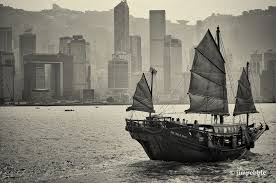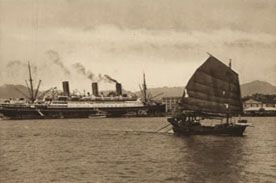History & Background
About Dukling
Hong Kong’s Victoria Harbour is one of the world's busiest harbours, with all kinds of ships criss-crossing the harbour day and night. Together with the Symphony of Lights at night and the dazzling skyline of Hong Kong, these sustain the glory of the Victoria Harbour.
If you have ever seen a red iconic traditional Chinese junk boat sailing in the Victoria Harbour among all these boats -- either online or in person, you might have seen Dukling before.
While there are multiple Chinese junk boats operating in the harbor, most of them are modern boats remodelled after antique ones, and Dukling is the only original Chinese junk that still regularly operates. Built in 1955, Dukling is now 67 years old and is the oldest Chinese junk left in Hong Kong. Before being a harbor cruise, it was used by former fishermen to go fishing and was their home. Because the shape of the hull looks like a duck, the owner named the boat Dukling, meaning Holy Duck. "Dukling" weighs 50 tons and has a length of 18 meters. It is a traditional three-mask Chinese wooden junk boat.
Dukling is not only an icon of Hong Kong, but also a collective memory of Hong Kong people. It witnessed the growth of Hong Kong from a small fishing village to an international metropolis today. Whenever you board this red iconic Chinese junk boat, it takes you down the memory lane to the Victoria Harbor in the 1960s and 1970s.
Currently, Dukling offers scheduled Victoria Harbour boat tours regularly, including sunset tours, the Symphony of Lights night cruise and Cultural Journeys to promote Hong Kong’s fishermen culture. It can also provide parties, charter, shooting, advertising, cultural experience tours, etc. We hope everyone can enjoy the combined experience of tradition and modernity by enjoying the scenery on the Victoria Harbour and savoring the everlasting passion of Hong Kong on this old traditional junk boat.
What are Chinese Junks?
Originally developed in the Warring State Period (475BC – 221BC), Chinese junks played an important role in the commercial, diplomatic and military development of ancient China. They were used in cross-ocean expeditions as a trading vessel, a military ship and a diplomatic boat, and appeared in renowned poems and artworks, such as Li Bai’s “The Hard Road” and Zhang Zeduan’s “Along the River During the Qingming Festival”.
In Admiral Zheng He’s Seven Sea Voyages in 1405-1433, his fleet comprised 30,000 men, with 1000 men in each junk. These were one of the biggest boats ever built in the world at that time. Chinese junks were also used extensively in Asian trade from the 16th to 19th century. One of these junks, Keying, even sailed from China around the Cape of Good Hope to the United States and Britain between 1846 and 1848.
These are all possible because Chinese junks incorporated numerous advanced technologies that were later adopted in modern Western shipbuilding. Cut elliptically and curved with bamboo inserts, the sails enable the junks to sail quickly and steadily. The flexible sails can be adjusted for various wind strengths, so junks could sail amidst any kind of weather.
Therefore, historian H. Warington Smith recognised the junk as one of the most efficient ship designs for carrying men and goods in high and stormy seas: "It is doubtful if any class of vessel is more suited or better adapted to its purpose than the Chinese junk"
With its long history and delicate design, Chinese junks are an important cultural heritage. As the oldest Chinese junk boat in Hong Kong, Dukling plays an important role in the preservation of our cultural heritage.





